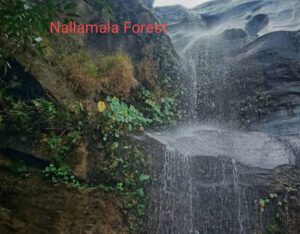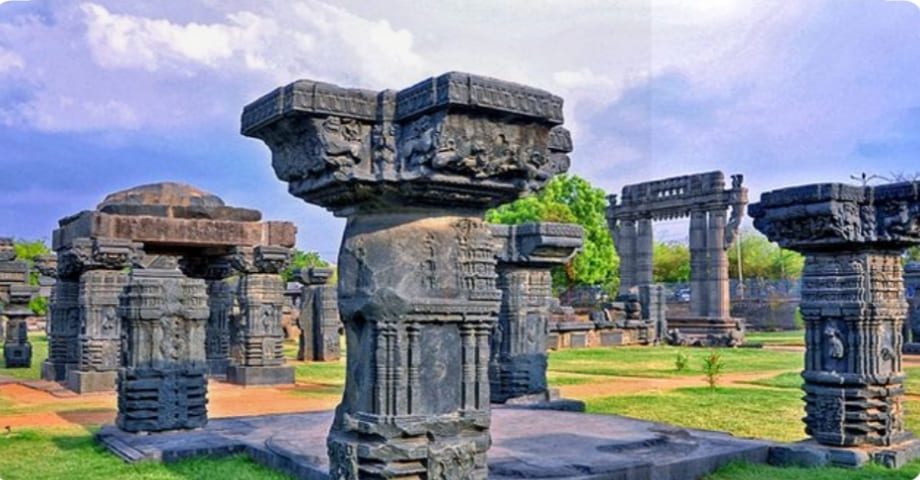The Nallamala Forest, spanning a vast area of 3000 square kilometers, is a natural wonder nestled in southern India. Located at the junction of Telangana and Seemandhra regions, it is renowned for its dense and pristine wilderness. This lush expanse is not only a testament to nature’s splendor but also holds historical significance. Once declared as the “Nagarjuna Sagar– Srisailam Tiger Sanctuary” and later renamed as the “Rajiv Gandhi Tiger Sanctuary,” it stands as a stronghold for biodiversity and conservation efforts. With its unique geography, rich wildlife, and cultural heritage, Nallamala Forest beckons adventurers and nature enthusiasts alike to explore its hidden treasures.
1. Historical Significance
• Tracing the history of Nallamala Forest
The history of Nallamala Forest is deeply intertwined with the cultural and ecological tapestry of southern India. Tracing its roots back through the ages reveals a fascinating narrative of human interaction and natural evolution.
1.Ancient Times : Nallamala history can be traced to ancient Indian civilizations. It is believed that this forest has been inhabited by tribal communities for thousands of years. These indigenous tribes, like the Chen chus, have long coexisted with the forest, relying on its resources for sustenance.
2.Spiritual Significance : The Nallamala Forest has profound spiritual significance. It is said to be a part of the sacred Dandakaranya mentioned in Hindu epics like the Ramayana. The renowned temple town of Srisailam, nestled within the forest, is a significant pilgrimage site for Hindus, adding to the area’s historical and religious importance.
3.Colonial Era : During British colonial rule, the forest attracted attention for its timber resources. Logging activities began, and the British established forest reserves in the region. The exploitation of the forest’s resources had a lasting impact on its ecosystem.
4.Post-Independence Conservation : After India gained independence, there was a growing awareness of the need for conservation. In 1983, a significant milestone was achieved when the Nallamala Forest was declared the “Nagarjuna Sagar – Srisailam Tiger Sanctuary.” This marked a shift towards preserving the rich biodiversity of the region.
5.Renaming to Rajiv Gandhi Tiger Sanctuary : In honor of the late Prime Minister Rajiv Gandhi, the sanctuary was renamed as the “Rajiv Gandhi Tiger Sanctuary.” This change not only recognized his contribution to environmental conservation but also highlighted the importance of the sanctuary on a national level.
6.Contemporary Conservation Efforts : Today, the Nallamala Forest is a focal point for conservation efforts. It is home to a wide variety of flora and fauna, including the critically endangered Indian tiger. Conservation organizations, government initiatives, and local communities work collaboratively to protect and preserve this natural treasure.
2. Biodiversity and Conservation
• Importance of biodiversity in Nallamala
The importance of biodiversity in the Nallamala Forest cannot be overstated. This unique ecosystem plays a crucial role on several fronts, contributing significantly to the region and the planet as a whole:
1. Ecosystem Stability: Biodiversity in Nallamala provides a robust and stable ecosystem. A variety of plant and animal species ensure that ecological processes such as pollination, nutrient cycling, and pest control remain balanced, benefiting both the forest and surrounding areas.
2. Medicinal Resources: Many plants and herbs in Nallamala have medicinal properties. Indigenous communities have relied on these resources for generations to treat various ailments. Preserving biodiversity ensures the continuation of these traditional healing practices.
3. Genetic Diversity: A diverse gene pool among plant and animal species is essential for their adaptation and survival. This genetic diversity can be invaluable in the face of changing environmental conditions, including climate change.
4. Tourism and Recreation: The rich biodiversity in Nallamala attracts tourists and nature enthusiasts. Eco-tourism not only supports the local economy but also raises awareness about the importance of preserving natural habitats.
5. Carbon Sequestration: Forests like Nallamala are vital for absorbing and storing carbon dioxide, a greenhouse gas contributing to climate change. The more diverse the forest, the more effective it is at sequestering carbon and mitigating climate impacts.
6. Food Security: The forest provides a variety of fruits, nuts, and edible plants, ensuring food security for local communities. Many indigenous tribes rely on these resources for their sustenance.
7. Wildlife Conservation: Nallamala is home to a wide range of wildlife, including endangered species like tigers and leopards. Preserving biodiversity is essential for the survival of these species and helps maintain the balance of predator-prey relationships.
8. Research and Education: Biodiversity hotspots like Nallamala serve as living laboratories for scientific research and education. Studying the interactions between species and their habitats can lead to valuable insights into ecological processes.
9. Cultural Significance: The diverse flora and fauna of Nallamala are deeply ingrained in the cultural heritage of the region. Many indigenous communities have spiritual and cultural connections to specific species and landscapes.
10. Long-Term Sustainability: A biodiverse ecosystem is more resilient to external threats such as disease outbreaks and invasive species. It increases the forest’s chances of long-term survival.
3 . Geography and Topography
• Detailed geography of Nallamala Forest
The geography of Nallamala Forest is characterized by diverse terrain, unique topographical features, and a wide range of ecosystems. Here’s a detailed overview of its geography:
1. Location: Nallamala Forest is situated in southern India, covering a vast area of approximately 3000 square kilometers. It straddles the border of Telangana and Seemandhra (now Andhra Pradesh) regions.
2.Altitude: The elevation of the forest varies significantly, ranging from approximately 100 meters above sea level in the low-lying areas to over 800 meters in the higher regions. This variation in altitude contributes to the diverse ecosystems within the forest.
3. Western and Eastern Ghats: Nallamala is part of the Eastern Ghats, a range of mountains that runs parallel to the east coast of India. It is also connected to the Western Ghats through the Nallamala Hills. These hills serve as a transition zone between the two major mountain ranges.
4. Rivers and Water bodies: The forest is crisscrossed by several rivers and streams, including the Krishna River, Tungabhadra River, and Pennar River. These water bodies support the rich biodiversity of the region and are essential for both wildlife and human communities.
5. Diverse Ecosystems: Nallamala geography encompasses a wide variety of ecosystems, from dense tropical forests to dry deciduous woodlands. It is also home to grasslands, rocky outcrops, and riparian zones along riverbanks.
6. Valleys and Plateaus: The forest features numerous valleys and plateaus, adding to its topographical diversity. These areas often host distinct flora and fauna adapted to their specific environmental conditions.
7. Caves and Karst Landscape: Nallamala is known for its limestone formations, which have led to the creation of several caves and underground streams. The Belum Caves, one of the longest cave systems in India, are located within the Nallamala Forest.
8. Rainfall: The forest receives moderate to heavy rainfall during the monsoon season, which plays a vital role in sustaining its lush vegetation and diverse wildlife.
9. Tiger Reserve: A significant portion of Nallamala Forest has been designated as the Rajiv Gandhi Tiger Reserve. This reserve covers approximately 3568.09 square kilometers within the larger forest area and is dedicated to the conservation of the endangered Bengal tiger.
10. Human Settlements: While Nallamala is primarily a forested region, it is not devoid of human habitation. Indigenous tribal communities, such as the Chen chus, have been residing in the forest for generations, coexisting with the natural environment.
4 . Wildlife in Nallamala Forest
• Highlighting the variety of wildlife species
Nallamala Forest is a biodiversity hotspot, teeming with a remarkable variety of wildlife species. Its rich and diverse ecosystem supports numerous animals, both common and critically endangered. Here are some of the prominent wildlife species found in this pristine forest:
1. Bengal Tiger (Panthera tigris tigris): The Nallamala Forest is home to the majestic Bengal tiger, one of the most iconic and endangered big cats in the world. The Rajiv Gandhi Tiger Reserve within the forest is dedicated to the conservation of this magnificent species.
2. Leopard (Panthera pardus): These elusive and agile predators roam the forest, adapting to its diverse landscapes. Leopards are known for their solitary nature and exceptional hunting skills.
3. Indian Elephant (Elephas maximus indicus): Herds of Indian elephants can be spotted in the forest, often near water sources. These gentle giants are a keystone species, shaping the forest ecosystem.
4. Indian Bison (Gaur – Bos gaurus): The Nallamala Forest is home to the Indian bison, one of the largest and most formidable bovine species. These herbivores play a crucial role in shaping the forest’s vegetation.
5. Sloth Bear (Melursus ursinus): These shaggy-coated bears are found in the forest and are known for their distinctive appearance and nocturnal habits.
6. Sambar Deer (Rusa unicolor): Sambar deer are a common sight in Nallamala, with their distinctive large size and impressive antlers.
7. Chital (Spotted Deer – Axis axis): These graceful, spotted deer are abundant in the forest and are often seen grazing in open areas.
8. Indian Pangolin (Manis crassicaudata): The Nallamala Forest is one of the habitats of the Indian pangolin, a unique and critically endangered species known for its scaly armor.
9. Indian Giant Squirrel (Ratufa indica): This vibrant and large tree-dwelling squirrel is found in the forest’s dense canopy.
10. Indian Peafowl (Pavo cristatus): The national bird of India, the Indian peafowl, or peacock, adds to the colorful biodiversity of Nallamala with its stunning plumage.
11. Birdlife: Nallamala is a birdwatcher’s paradise with over 200 bird species, including the Indian eagle-owl, crested serpent eagle, Indian pitta, and many migratory species that visit seasonally.
12. Reptiles and Amphibians: The forest is also home to a variety of reptiles and amphibians, including the Indian python, king cobra, various species of frogs, and tortoises.
13. Insects and Butterflies: The diversity extends to insects and butterflies, making Nallamala a hotspot for entomologists and lepidopterists.
The Nallamala Forest’s exceptional variety of wildlife species highlights its importance as a biodiversity hotspot. This rich and balanced ecosystem is not only a sanctuary for these creatures but also a critical area for conservation efforts to protect these species and their habitats.
5 . Cultural and Tribal Influence
• Role of Nallamala in the cultural heritage of the region
Nallamala Forest plays a significant and multifaceted role in the cultural heritage of the region, deeply ingrained in the traditions, folklore, and spirituality of the local communities. Here are some key aspects of its cultural significance:
1. Spiritual and Religious Significance: Nallamala Forest is home to the renowned Srisailam Temple, dedicated to Lord Shiva and Goddess Parvati. This temple is one of the twelve Jyotirlinga shrines and holds immense religious importance for Hindus. Pilgrims from far and wide visit the temple, making it a central hub for religious and cultural gatherings.
2. Mythological and Historical Legends: According to Hindu mythology, Nallamala is believed to be a part of the Dandakaranya forest mentioned in the epic Ramayana. The forest also finds mention in various other ancient texts, adding to its historical and mythological significance.
3. Indigenous Tribal Communities: The forest is inhabited by indigenous tribal communities, including the Chen Chus. These communities have their unique cultural practices, traditions, and folklore closely tied to the forest. Their customs and rituals often revolve around nature and its bounties.
4. Traditional Healing Practices: Nallamala rich biodiversity has contributed to the traditional healing practices of local communities. Many herbs and plants found in the forest are used in traditional medicine, highlighting the forest’s role in healthcare practices.
5. Festivals and Celebrations: The region hosts numerous festivals and cultural celebrations, often centered around the temple. Festivals like Maha Shivaratri and Brahmotsavam attract thousands of devotees and tourists, showcasing the cultural vibrancy of the area.
6. Art and Craft: Indigenous communities in Nallamala are known for their unique art and craft forms. They create traditional artifacts, paintings, and handicrafts, reflecting their connection to nature and their cultural heritage.
7. Tribal Traditions: The forest is a repository of tribal traditions, including folk dances, songs, and storytelling. These traditions are passed down through generations and provide insights into the rich cultural tapestry of Nallamala.
8. Conservation and Cultural Bond: The cultural heritage of the region is intertwined with the conservation efforts in Nallamala. Many local communities actively participate in conservation initiatives, fostering a strong bond between culture and environmental stewardship.
9. Tourism and Cultural Exchange: Nallamala cultural heritage is also shared with tourists and visitors. Eco-tourism initiatives promote cultural exchange, allowing outsiders to appreciate and learn from the region’s rich traditions.
6. Ecotourism Opportunities
• Overview of ecotourism in Nallamala
Ecotourism in Nallamala is a growing and sustainable way to explore the natural beauty and cultural richness of this pristine forest. Here’s an overview of ecotourism in Nallamala:
1. Rich Biodiversity: Nallamala’ lush greenery, diverse wildlife, and scenic landscapes make it an ideal destination for ecotourism. Tourists have the opportunity to witness a wide variety of flora and fauna in their natural habitat.
2. Tiger Reserve: The Rajiv Gandhi Tiger Reserve within Nallamala is a major attraction for wildlife enthusiasts. Guided safaris and treks offer a chance to spot the elusive Bengal tiger, along with other wildlife like leopards, elephants, and various bird species.
3. Scenic Beauty: The forest’s diverse topography, including hills, valleys, rivers, and caves, provides stunning scenic views. Visitors can explore the forest’s unique landscapes through trekking, hiking, and nature walks.
4. Cultural Experience: Ecotourism in Nallamala provides an opportunity to interact with indigenous tribal communities like the Chen chus. Tourists can learn about their traditional lifestyles, customs, and cultural practices, fostering cultural exchange and understanding.
5. Adventure Activities: The forest offers a range of adventure activities such as rock climbing, rappelling, and camping. These activities allow tourists to connect with nature while enjoying thrilling experiences.
6. Birdwatching: Nallamala is a haven for birdwatchers, with over 200 bird species. Birdwatching tours enable enthusiasts to observe and photograph colorful and rare avian species.
7. Flora Exploration: The forest’s diverse flora, including medicinal plants and unique tree species, is a point of interest for botanists and nature lovers. Guided tours provide insights into the forest’s plant life.
8. Educational Programs: Ecotourism initiatives often include educational programs and nature interpretation centers. These programs raise awareness about the importance of conservation and sustainable tourism practices.
9. Conservation Efforts: Many ecotourism projects in Nallamala are closely linked with conservation efforts. Visitors can learn about the challenges of preserving this delicate ecosystem and how they can contribute to its protection.
10. Responsible Tourism: Ecotourism in Nallamala emphasizes responsible and sustainable tourism practices. This includes respecting the environment, minimizing the ecological footprint, and supporting local communities.
11. Accommodations: There are eco-friendly accommodations available near the forest, ranging from rustic lodges to comfortable resorts. These establishments often adhere to environmentally friendly practices.
12. Permit and Regulations: To protect the forest and its wildlife, visitors are required to obtain permits and follow strict regulations. This ensures that ecotourism activities are carried out responsibly.

7 . Conservation Initiatives
• Government and NGO efforts to protect Nallamala
The protection of Nallamala Forest is a collective effort involving both government agencies and non-governmental organizations (NGOs). These organizations work tirelessly to safeguard the rich biodiversity and ecological significance of the forest. Here’s an overview of their efforts
1.Rajiv Gandhi Tiger Reserve: The government has designated a significant portion of Nallamala as the Rajiv Gandhi Tiger Reserve. This reserve is dedicated to the conservation of the Bengal tiger and its habitat. It’s managed as a protected area to prevent poaching and habitat degradation.
2. Wildlife Conservation: Government agencies like the Telangana Forest Department and the Andhra Pradesh Forest Department play a pivotal role in wildlife conservation in Nallamala. They conduct regular patrols, monitor wildlife populations, and manage habitat restoration.
3. Community Engagement: Government initiatives involve engaging local communities, especially indigenous tribes like the Chen chus, in forest conservation. These communities are often employed as forest guards and guides, creating a sense of ownership and responsibility for protecting the forest.
4. Anti-Poaching Measures: Government agencies implement strict anti-poaching measures, including the use of technology such as camera traps, to combat illegal hunting and trade in wildlife products.
5. Awareness and Education: Government departments conduct awareness programs and educational campaigns to educate locals and tourists about the importance of forest conservation and responsible tourism.
6. Research and Monitoring: Ongoing research and monitoring of wildlife and ecosystems in Nallamala help inform conservation strategies and policies. This includes population surveys, habitat assessments, and ecological studies.
Conclusion :
Nallamala Forest, spanning 3000 square kilometers in southern India, stands as a natural treasure trove and cultural heritage hub. Its rich biodiversity, home to iconic species like the Bengal tiger, plays a pivotal role in ecological balance and global conservation efforts. Nallamala’ sacred temples, indigenous tribal communities, and traditional healing practices showcase its deep cultural roots. The forest serves as an eco-tourism hotspot, offering immersive experiences while promoting responsible travel. Government and NGO initiatives are dedicated to its preservation, highlighting its ecological importance. In summary, Nallamala Forest is a vital sanctuary, blending nature’s wonders with cultural heritage and environmental stewardship.
FAQs:
1. Can we stay in Nallamala forest?
Yes, there are accommodations within Nallamala Forest, including resorts and cottages, allowing visitors to stay and enjoy its beauty.
2. What is Nallamala forest famous for?
Nallamala Forest is renowned for its rich biodiversity, cultural significance, and as a tiger reserve.
3. Is there safari in Nallamala forest?
Yes, Nallamala Forest offers safari experiences for tourists to explore its diverse wildlife and scenic landscapes.
4. What are the Nallamala Hills famous for?
Nallamala Hills are famous for their stunning landscapes, biodiversity, and as a transition zone between Eastern and Western Ghats.
5. Nallamala forest resorts price
Nallamala forest resort prices vary based on the type of accommodation and amenities offered.
6. Nallamala forest resorts packages
Nallamala forest resort packages may include accommodation, meals, and guided tours.
7.Nallamala forest resorts map
Nallamala forest resort maps can help you locate accommodations within the forest.
8.Best nallamala forest resorts
Explore the best Nallamala forest resorts for a comfortable and immersive stay.
9. Nallamala forest tourism packages
Discover Nallamala forest tourism packages for guided tours and experiences in this pristine wilderness.
10. Nallamala forest cottages
Nallamala forest cottages provide cozy and rustic lodging options amid nature’s beauty.




